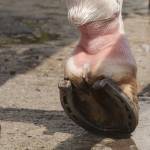Equine Nutrition: Horse Owners Note Top Concerns

If you ask a group of equine nutritionists and veterinarians, they will tell you nutrition-related disorders are on the rise, largely due to overfeeding. One recent survey* concurred, identifying the top five nutrition-related disorders as insulin resistance or equine metabolic syndrome; equine Cushing’s disease; recurrent equine rhabdomyolysis; equine gastric ulcer syndrome; and recurrent airway obstruction.
According to that same survey, though, horse owners had a completely different list of nutrition-related disorders. Here are some tips and links for managing the most important ailments that you, horse owners and caretakers, have noted.
1. Hoof conditions and laminitis. Laminitis is one of the most common and serious foot problems that concerns owners. Described as a painful separation of the hoof wall from the coffin bone, laminitis is a life-threatening condition.
“There are several causes and factors contributing to the development of laminitis such as systemic inflammation or infection and supporting limb laminitis, but sudden changes in diet—such as overconsumption of grain or concentrates or lush pasture—are top of that list,” said Peter Huntington, B.V.Sc., M.A.C.V.Sc., director of nutrition at Kentucky Equine Research (Australia). “All diet changes should be made slowly and horses with a history of laminitis need to be managed carefully to ensure easily digestible sugars are not offered.”
For horses that need a higher level of hoof-related nutrients in their diet, Kentucky Equine Research offers Bio-Bloom PS (Bio-Bloom HF in Australia) to provide additional support for hoof quality and growth.
2. Joint longevity. Osteoarthritis is a painful degeneration of the articular cartilage lining the bones inside joints. There is no cure, and the condition can affect horses of any age, limiting athleticism.
“Joint supplements are among the most common nutritional product offered to horses and can contain a large and varied type and amount of ingredient to support joint health,” said Huntington.
Not all supplements are equally effective, and poor-quality supplements abound. Be sure to select a quality product to maximize the benefits for your horse. Kentucky Equine Research offers several products that support joint health in active horses. KER-Flex, available in the U.S., contains a synergistic blend of glucosamine HCl and chondroitin sulfate in a form that is suitable for all classes of horses engaged in various types of exercise. For clients in Australia, Glucos-A-Flex contains a blend of glucosamine hydrochloride, vitamins, minerals, amino acids and antioxidants shown to be beneficial for joint health and function.
3. Colic care. Similar to hoof care, there are many underlying causes that contribute to colic. Sand ingestion, age (pedunculated lipomas in older horses, for example), and changes in management or diet, including water intake, instigate the development of colic. Try to avoid any sudden changes in your horse’s daily routine, and make diet changes—such as those occurring in spring and fall—gradually.
4. Care of the senior horse. Horses are living longer, healthier lives thanks to medical advances and willingness of owners to pamper this special population.
“The most important way to ensure the health of a senior horse is to have a full physical examination performed by a veterinarian at least once a year,” recommended Huntington. “This will provide an excellent opportunity to discuss diet, body condition, deworming, vaccination, dentition, hoof health, and to ensure any ongoing medical issues such as heaves or arthritis are being managed appropriately.”
*Murray, J.D., C. Bloxham, J. Kulifay, et al. Equine nutrition: a survey of perceptions and practices of horse owners undertaking a massive open online course in equine nutrition. Journal of Equine Veterinary Science. In press.








